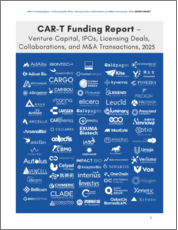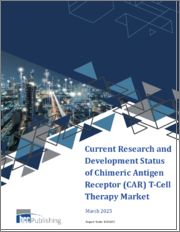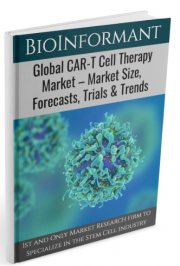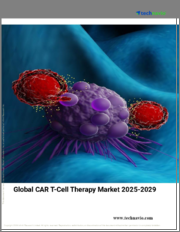
|
시장보고서
상품코드
1616882
CAR-T 세포치료 시장 : 표적 항원별, 적응증별, 주요 지역별, 약제 판매 예측, 주요 기업 : 업계 동향과 세계 예측(-2035년)CAR T-Cell Therapy Market by Target Antigens, Target Indication, Key Geographies, Sales Forecast of Drugs and Leading Players: Industry Trends and Global Forecasts, Till 2035 |
||||||
세계의 CAR-T 세포치료 시장 규모는 2035년까지의 예측 기간 중 11.4%의 CAGR로 확대하며, 현재 46억 달러에서 2035년까지 152억 달러로 성장할 것으로 예측됩니다.
암 연구는 제약업계에서 의약품 개발이 가장 활발한 분야 중 하나입니다. 실제로 지난 수년간 미국 FDA는 다양한 유형의 암 치료제로 70개 이상의 의약품을 승인했습니다. 비특이성 등 기존 치료법의 문제점을 감안해 제약사들은 보다 표적화된 항암제 치료법을 적극적으로 연구하고 있습니다. CAR-T 세포 치료는 암세포를 표적으로 삼아 제거하기 위해 신체 자체의 면역 체계를 활용하는 CAR-T 세포 치료는 질병을 완전히 완화시키고 추가 치료의 필요성을 없애는 것으로 입증되었으며, 여러 연구에서 이러한 치료 후보의 효능이 입증되었습니다. 여러 연구에서 이러한 치료 후보물질의 효능이 입증되었습니다. 지난 8년 동안 CAR-T 세포 치료와 관련된 1,000개에 가까운 임상시험이 등록되었습니다는 점은 주목할 만합니다. 현재 230개 이상의 기업이 암, 비암 및 기타 다양한 질병을 치료하기 위해 CAR-T 세포치료제 개발에 참여하고 있습니다.

분자 연구의 기술 발전과 더불어 맞춤형 암 치료에 대한 수요 급증, 임상시험 및 여러 치료법의 승인 건수 증가 등이 이 시장의 성장을 가속하는 주요 요인으로 작용하고 있습니다. 또한 투자자들의 지속적인 자금 지원은 중장기적으로 CAR-T 세포치료제 개발의 꾸준한 성장을 촉진할 것으로 예상됩니다.

세계의 CAR-T 세포치료 시장에 대해 조사했으며, 시장의 개요와 표적 항원별, 적응증별, 지역별 동향 및 시장에 참여하는 기업의 개요 등을 제공하고 있습니다.
목차
제1장 서문
제2장 조사 방법
제3장 경제 및 기타 프로젝트 특유의 고려 사항
제4장 개요
제5장 서론
제6장 CAR-T 세포치료 : 시장 구도
제7장 중요한 인사이트
제8장 임상시험 분석
제9장 주요 업계 리더
제10장 기업 개요
- 장의 개요
- Autolus
- Bluebird Bio
- Bristol Myers Squibb
- CARsgen Therapeutics
- Cellectis
- Gilead Sciences
- Innovative Cellular Therapeutics
- Noile-Immune Biotech
- Novartis
- Sinobioway Cell Therapy
- Takara Bio
- Wellington Zhaotai Therapies
제11장 파트너십과 협업
제12장 자금조달과 투자 분석
제13장 특허 분석
제14장 사례 연구 : 세포치료의 제조
제15장 원가분석
제16장 시장에 대한 영향 분석 : 촉진요인, 억제요인, 기회, 과제
제17장 세계의 CAR-T 세포치료 시장
제18장 CAR-T 세포치료 시장, 표적 항원별
제19장 CAR-T 세포치료 시장, 적응증별
제20장 CAR-T 세포치료 시장, 주요 지역별
제21장 CAR-T요법 시장, 의약품 판매 예측
제22장 CAR-T 세포치료 시장 : 주요 기업의 판매 예측
제23장 프로모션 분석
제24장 이그제큐티브 인사이트
제25장 결론
제26장 부록 I : 표 형식 데이터
제27장 부록 II : 기업 및 단체 리스트
제28장 부록 III : 자금 및 투자 리스트
KSA 24.12.30CAR T-CELL THERAPY MARKET: OVERVIEW
As per Roots Analysis, the global CAR T-cell therapy market is estimated to grow from USD 4.6 billion in the current year to USD 15.2 billion by 2035, at a CAGR of 11.4% during the forecast period, till 2035.
The market sizing and opportunity analysis has been segmented across the following parameters:
Target Indication
- Acute Lymphoblastic Leukemia
- Diffuse Large B-cell Lymphoma
- Follicular Lymphoma
- Large B-cell Lymphoma
- Mantle Cell Lymphoma
- Multiple Myeloma
- Others
Target Antigen
- CD19
- BCMA
- CD20
- CD19 / CD22
- Others
Key Players
- Gilead Sciences
- Bristol Myers Squibb
- Novartis
- Janssen
- JW Therapeutics
Key Geographical Regions
- North America
- US
- Canada
- Europe
- Germany
- France
- Italy
- Spain
- UK
- Rest of Europe
- Asia-Pacific
- Japan
- India
- China
- Australia
- South Korea
- Rest of Asia Pacific
- Latin America
- Middle East and North Africa
- Rest of the World
Key Drugs
- Yescarta
- Kymriah
- Abecma
- Breyanzi
- Carvykti
- Tecartus
- Others
CAR T-CELL THERAPY MARKET: GROWTH AND TRENDS
Cancer research continues to be one of the most active segments, in terms of drug development, within the pharmaceutical industry. In fact, in the past few years, the USFDA has approved more than 70 drugs for the treatment of different types of cancer. Given the challenges associated with conventional therapies, such as non-specificity, drug developers are actively investigating more targeted anti-cancer therapies. Of these, CAR T-cell therapies have emerged as a promising option. CAR T-cell therapy leverages the body's own immune system to target and eliminate cancer cells. CAR-T cell therapies have been demonstrated to enable complete disease remission, omitting the need for additional treatment; several studies have proven the efficacy of these therapy candidates. It is worth highlighting that close to 1,000 clinical trials related to CAR-T cell therapies have been registered in the past eight years, indicating substantial research activity. At present, over 230 companies are engaged in the development of CAR T-cell therapies for the treatment of different oncological, non-oncological and other disorders.
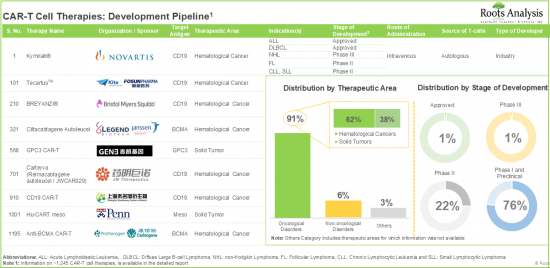
Along with the technological advancements in molecular research, the surge in demand for personalized cancer treatment and increase in the number of clinical trials and multiple therapy approvals are some other considerable factors, aiding the growth of this market. Furthermore, continuous financial support from investors is expected to propel the steady growth for the development of CAR-T cell therapy in the mid to long-term.
CAR T-CELL THERAPY MARKET: KEY INSIGHTS
The report delves into the current state of the CAR T-cell therapy market and identifies potential growth opportunities within the industry. Some key findings from the report include:
1. CAR-T cell therapies, with over 1240 preclinical / clinical product candidates, represent one of the most active segments in the pharmaceutical domain.
2. Close to 75% of the therapy candidates, which are being developed to target a range of disease indications, are autologous in nature; notably, CD19 and BCMA have emerged as the most popular target antigens.
3. Extensive efforts are underway to improve CAR constructs across successive generations, involving alterations in the scFv region via using different types of gene delivery vectors.
4. Close to 200 players claim to have the required capabilities to manufacture different types of cell therapies; such firms also offer a wide range of services across different stages of product development.
5. In the last eight years, over 970 clinical trials have been registered across different geographies for CAR-T cell therapies; extensive efforts are underway to improve successive generations of these therapies.
6. 375+ scientists from renowned universities are presently involved in the clinical development of CAR-T cell therapies; these KOLs are primarily based in the US and China.
7. The rise in partnerships, in the recent past, involving both international and indigenous stakeholders, validate the growing interest in this domain.
8. Several investors, having realized the opportunity within this upcoming segment of cancer immunotherapy, have invested more than USD 32 billion, across 370+ instances.
9. More than 11,900 patents related to CAR-T cell therapies have been filed / granted to protect the intellectual property generated within this field.
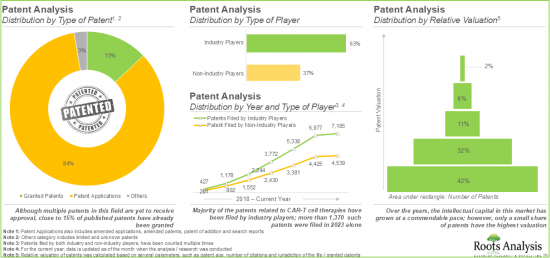
10. In order to efficiently promote these therapies and sustain their position in the CAR-T cell therapies market, drug developers are actively exploring diverse promotional strategies.
11. Considering the growing prevalence of cancer, technological developments and ongoing approvals, the market for CAR-T cell therapies is poised to witness a steady growth in the foreseen future.
12. With a growing focus on the development pipeline and encouraging clinical results, the market is anticipated to witness an annualized growth rate of over 10%, during the next decade.
CAR T-CELL THERAPY MARKET: KEY SEGMENTS
Multiple Myeloma is Likely to Dominate the CAR T-Cell Therapy Market During the Forecast Period
Based on target indication, the market is segmented into acute lymphoblastic leukemia, diffuse large B-cell lymphoma, follicular lymphoma, large B-cell lymphoma, mantle cell lymphoma, multiple myeloma and others. It is worth highlighting that the market for CAR-T therapies designed to treat large B-cell lymphoma is projected to grow at an annual growth rate of 14%, during the forecast period.
CD19 Targeting Therapies is Expected to Capture Largest Share in the CAR T-Cell Therapy Market During the Forecast Period
Based on target antigen, the market is segmented into CD19, BCMA, CD20, CD19 / CD22 and others. It is worth highlighting that the segment for CD19 is likely to capture more than 65% of the overall market in the coming years. This can be attributed to the success of CD19 targeting therapies, such as Kymriah(R) (tisagenlecleucel) and Yescarta(R) (axicabtagene ciloleucel).
North America Accounts for the Largest Share of the Market
Based on key geographical regions, the market is segmented into North America, Europe, Asia-Pacific, Latin America, Middle East and North Africa, and Rest of the World. It is worth highlighting that over the years, the market in Asia-Pacific is expected to grow at a higher CAGR.
Example Players in the CAR T-Cell Therapy Market
- Autolus
- Bluebird Bio
- Bristol Myers Squibb
- Carsgen Therapeutics
- Cellectis, Gilead Sciences
- Innovative Cellular Therapeutics
- Noile-Immune Biotech
- Novartis
- Shanghai GeneChem
- Sinobioway Cell Therapy
- Takara Bio
- Wellington Zhaotai Therapies
Primary Research Overview
The opinions and insights presented in this study were influenced by discussions conducted with multiple stakeholders. The research report features detailed transcripts of interviews held with the following industry stakeholders:
- Chief Executive Officer, Glycostem Therapeutics
- Chief Executive Officer, Gracell Biotechnologies
- Chief Operating Officer, TxCell
- Vice President, Scientific Affairs, Kite Pharma
- Vice President, Immuno-Oncology, Celyad
- Manager of Business Development, Waisman Biomanufacturing Competitive Intelligence Manager, Strategy & Business Development, Theravectys
- Professor of Medicine and Director, Department of Oncology, Changhai Hospital
- Assistant Professor of Medicine, University of Colorado
CAR T-CELL THERAPY MARKET: RESEARCH COVERAGE
- The report features an in-depth analysis of the CAR T-cell therapy market, focusing on key market segments, including target antigens, target indication, key geographical regions, sales forecast of drugs and leading players.
- The report analyzes various factors such as drivers, restraints, opportunities, and challenges affecting the market growth.
- A comprehensive evaluation of the current market landscape of CAR-T cell therapies, considering various parameters, such as type of developer (industry and non-industry), phase of development (approved, phase III, phase II / III, phase II, phase I / II, phase I, clinical (phase unknown), preclinical), therapeutic area (oncological disorders, non-oncological disorders and undisclosed), key target indication (acute lymphoblastic leukemia, B-cell lymphoma, multiple myeloma, non-Hodgkin lymphoma, acute myeloid leukemia, hepatocellular carcinoma, diffuse large B-cell lymphoma, pancreatic cancer, gastric cancer, lung cancer, mantle cell lymphoma, ovarian cancer, HER2-positive breast cancer and follicular lymphoma), key target antigen (CD19, BCMA, CD19 / CD22, GPC3, NY-ESO-1 and others), source of T-cells (autologous and allogeneic), route of administration (intravenous, intratumoral, intraperitoneal, intrapleural, intracranial and others), dose frequency (single dose, multiple doses and split doses), patient segment (children, adults and seniors) and type of therapy (monotherapy and combination therapy). It also provides an assessment of the companies involved in the development of CAR T-cell therapies based on their year of establishment, company size and location of headquarters.
- Examination of completed, ongoing, and planned clinical studies based on parameters, such as trial registration year, enrolled patient population, trial recruitment status, trial phase, target patient segment, type of sponsor / collaborator, most active players and regional distribution of trials.
- An analysis of key insights derived from the study featuring a competitive analysis, emphasizing the prevalent target antigens associated with hematological malignancies and solid tumors. Additionally, it includes CAR construct analysis of clinical-stage CAR T cell therapies based on the generation of CAR (first generation, second generation, third generation and fourth generation), type of binding domain (murine, humanized, fully human and rabbit derived), type of virus used (lentivirus and retrovirus), type of gene transfer method used (transduction and transfection) and type of co-stimulatory domain used.
- An in-depth examination that emphasizes the key opinion leaders (KOLs) within this field includes an evaluation of various principal investigators overseeing clinical trials associated with CAR-T therapies. These investigators are recognized as KOLs due to their active engagement in the research and development of CAR T cell therapies. Additionally, the chapter provides a comparative analysis of the KOLs' expertise, utilizing a proprietary scoring system alongside assessments from third-party evaluations.
- In-depth profiles of key players in CAR T-cell therapy market, focusing on company overviews, and a brief description of the product portfolio specific to CAR-T therapies, technology portfolio (if available), recent developments related to CAR-T cell therapies and manufacturing capabilities of the companies. In addition, it also includes details of the strategic / venture capital investments made in these companies.
- An analysis of partnerships established in this sector, covering R&D agreements, license agreements (specific to technology platforms and therapy candidates), product development and commercialization agreements, manufacturing agreements, clinical trial collaborations, product supply management agreements, joint ventures and others.
- A detailed evaluation of the investments made in CAR T cell therapy companies with proprietary therapies and technologies, encompassing seed funding, venture capital, capital raised through IPOs and follow-on offerings, as well as grants and debt financing.
- Detailed analysis of over 11,900 patents filed or granted related to CAR T-cell therapies based on type of patent, publication year, geographical distribution, Cooperative Patent Classification (CPC) symbols, emerging focus areas, type of applicant, leading players (on the basis of number of patents filed / granted), patent valuation and patent benchmarking.
- A case study focused on the production of cell therapy products, emphasizing the challenges and providing a comprehensive list of contract service providers and in-house manufacturers involved in this domain.
- A comprehensive evaluation of the various factors that underpin the pricing of cell-based therapies. It includes different models and strategies that a pharmaceutical company might consider when determining the price of a CAR-T cell therapy expected to be launched in the near future.
- An analysis of the primary promotional strategies employed by the developers of approved CAR T cell therapies, including Tisagenlecleucel-T (KYMRIAH(R)), Axicabtagene ciloleucel (YESCARTA(R)), Brexucabtagene Autoleucel (TECARTUS(TM)), Lisocabtagene maraleucel (Breyanzi(R)), Idecabtagene Vicleucel (Abecma(TM)), and Ciltacabtagene Autoleucel (CARVYKTI(TM)), among others.
KEY QUESTIONS ANSWERED IN THIS REPORT
- How many companies are currently engaged in this market?
- Which are the leading companies in this market?
- What kind of partnership models are commonly adopted by industry stakeholders?
- How many clinical trials are running for CAR-T therapies?
- What are the factors that are likely to influence the evolution of this market?
- What is the current and future market size?
- What is the CAGR of this market?
- How is the current and future market opportunity likely to be distributed across key market segments?
REASONS TO BUY THIS REPORT
- The report provides a comprehensive market analysis, offering detailed revenue projections of the overall market and its specific sub-segments. This information is valuable to both established market leaders and emerging entrants.
- Stakeholders can leverage the report to gain a deeper understanding of the competitive dynamics within the market. By analyzing the competitive landscape, businesses can make informed decisions to optimize their market positioning and develop effective go-to-market strategies.
- The report offers stakeholders a comprehensive overview of the market, including key drivers, barriers, opportunities, and challenges. This information empowers stakeholders to stay abreast of market trends and make data-driven decisions to capitalize on growth prospects.
ADDITIONAL BENEFITS
- Complimentary PPT Insights Packs
- Complimentary Excel Data Packs for all Analytical Modules in the Report
- 10% Free Content Customization
- Detailed Report Walkthrough Session with Research Team
- Free Updated report if the report is 6-12 months old or older
TABLE OF CONTENTS
1. PREFACE
- 1.1. Introduction
- 1.2. Market Share Insights
- 1.3. Key Market Insights
- 1.4. Report Coverage
- 1.5. Key Questions Answered
- 1.6. Chapter Outlines
2. RESEARCH METHODOLOGY
- 2.1. Chapter Overview
- 2.2. Research Assumptions
- 2.3. Project Methodology
- 2.4. Forecast Methodology
- 2.5. Robust Quality Control
- 2.6. Key Market Segmentations
- 2.7. Key Considerations
- 2.7.1. Demographics
- 2.7.2. Economic Factors
- 2.7.3. Government Regulations
- 2.7.4. Supply Chain
- 2.7.5. COVID Impact / Related Factors
- 2.7.6. Market Access
- 2.7.7. Healthcare Policies
- 2.7.8. Industry Consolidation
3. ECONOMIC AND OTHER PROJECT SPECIFIC CONSIDERATIONS
- 3.1. Chapter Overview
- 3.2. Market Dynamics
- 3.2.1. Time Period
- 3.2.1.1. Historical Trends
- 3.2.1.2. Current and Forecasted Estimates
- 3.2.2. Currency Coverage
- 3.2.2.1. Overview of Major Currencies Affecting the Market
- 3.2.2.2. Impact of Currency Fluctuations on the Industry
- 3.2.3. Foreign Exchange Impact
- 3.2.3.1. Evaluation of Foreign Exchange Rates and Their Impact on Market
- 3.2.3.2. Strategies for Mitigating Foreign Exchange Risk
- 3.2.4. Recession
- 3.2.4.1. Historical Analysis of Past Recessions and Lessons Learnt
- 3.2.4.2. Assessment of Current Economic Conditions and Potential Impact on the Market
- 3.2.5. Inflation
- 3.2.5.1. Measurement and Analysis of Inflationary Pressures in the Economy
- 3.2.5.2. Potential Impact of Inflation on the Market Evolution
- 3.2.1. Time Period
4. EXECUTIVE SUMMARY
5. INTRODUCTION
- 5.1. Chapter Overview
- 5.2. Overview of T-cell Immunotherapies
- 5.2.1. Historical Evolution
- 5.2.2. Key Considerations for Developing T-cell Immunotherapies
- 5.2.3. Strategies Employed for the Redirection of T-cells
- 5.2.4. Manufacturing of Engineered T-cells
- 5.3. Chimeric Antigen Receptor T-cell (CAR-T) Therapy
- 5.3.1. Development History
- 5.3.2. Structure of CAR
- 5.3.2.1. Ectodomain
- 5.3.2.2. Transmembrane (TM) Domain
- 5.3.2.3. Endodomain
- 5.3.3. Development of CAR-T Cells
- 5.3.4. Universal CAR-T Cells
- 5.3.5. Route of Administration
- 5.3.6. Challenges Associated with CAR-T Cell Therapies
- 5.3.6.1. Competitive Risks
- 5.3.6.2. Clinical Risks
- 5.3.6.3. Regulatory Risks
- 5.3.6.4. Commercial Risks
- 5.4. Concluding Remarks
6. CAR-T CELL THERAPIES: MARKET LANDSCAPE
- 6.1. Chapter Overview
- 6.2. CAR-T Cell Therapies: Market Landscape
- 6.2.2. Analysis by Stage of Development
- 6.2.3. Analysis by Type of Therapy
- 6.2.4. Analysis by Target Antigen
- 6.2.5. Analysis by Target Indication
- 6.2.6. Analysis by Therapeutic Area
- 6.2.7. Analysis by Stage of Development and Therapeutic Area
- 6.2.8. Analysis by Source of T-cells
- 6.2.9. Analysis by Stage of Development and Source of T-cells
- 6.2.10. Analysis by Route of Administration
- 6.2.11. Analysis by Dosage Regimen
- 6.2.12. Analysis by Target Patient Population
- 6.2.13. Most Active Industry Players: Analysis by Number of Therapies
- 6.2.14. Most Active Non-Industry Players: Analysis by Number of Therapies
- 6.3. CAR-T Cell Therapies: Overall Developer Landscape
- 6.3.1. Analysis by Year of Establishment
- 6.3.2. Analysis by Company Size
- 6.3.3. Analysis by Location of Headquarters
7. KEY INSIGHTS
- 7.1. Chapter Overview
- 7.2. CAR-T Cell Therapies: Popular Target Antigens
- 7.2.1. Popular Targets for Hematological Malignancies
- 7.2.2. Popular Targets for Solid Tumors
- 7.3. CAR-T Therapies: CAR Construct Analysis
- 7.3.1. Analysis by Generation of CAR
- 7.3.2. Analysis by Type of scFv Antibody Used
- 7.3.3. Analysis by Type of Virus Used
- 7.3.4. Analysis by Type of Gene Transfer Method Used
- 7.3.5. Analysis by Type of Co-Stimulatory Domain
8. CLINICAL TRIAL ANALYSIS
- 8.1. Chapter Overview
- 8.2. Scope and Methodology
- 8.3. CAR-T Cell Therapies: Clinical Trial Analysis
- 8.3.1. Analysis by Trial Registration Year
- 8.3.2. Analysis of Enrolled Patient Population by Trial Registration Year
- 8.3.3. Analysis by Trial Phase
- 8.3.4. Analysis of Enrolled Patient Population by Trial Phase
- 8.3.5. Analysis by Trial Registration Year and Trial Phase
- 8.3.6. Analysis by Trial Status
- 8.3.7. Analysis by Patient Gender
- 8.3.8. Analysis by Therapeutic Area
- 8.3.9. Analysis by Study Design
- 8.3.10. Most Active Industry Players: Analysis by Number of Registered Trials
- 8.3.11. Most Active Non-Industry Players: Analysis by Number of Registered Trials
- 8.3.13. Analysis by Geography
9. KEY OPINION LEADERS
- 9.1. Chapter Overview
- 9.2. Assumptions and Key Parameters
- 9.3. Methodology
- 9.4. CAR-T Cell Therapies: Key Opinion Leaders
- 9.4.1. Analysis by Type of Organization
- 9.4.2. Analysis by Affiliated Organization
- 9.4.3. Analysis by Geographical Location of KOLs
- 9.4.4. KOL Activeness versus KOL Strength
- 9.4.5. Most Prominent KOLs: Analysis by RA score
- 9.4.6. Most Prominent KOLs: Comparison of RA Score and Third-Party Score
10. COMPANY PROFILES
- 10.1. Chapter Overview
- 10.2. Autolus
- 10.3. Bluebird Bio
- 10.4. Bristol Myers Squibb
- 10.5. CARsgen Therapeutics
- 10.6. Cellectis
- 10.7. Gilead Sciences
- 10.8. Innovative Cellular Therapeutics
- 10.9. Noile-Immune Biotech
- 10.10. Novartis
- 10.11. Sinobioway Cell Therapy
- 10.12. Takara Bio
- 10.13. Wellington Zhaotai Therapies
11. PARTNERSHIPS AND COLLABORATIONS
- 11.1. Chapter Overview
- 11.2. Partnership Models
- 11.3. CAR-T Cell Therapies: Partnerships and Collaborations
- 11.3.1. Analysis by Year of Partnership
- 11.3.2. Analysis by Type of Partnership
- 11.3.3. Analysis by Year and Type of Partnership
- 11.3.4. Analysis by Type of Partner
- 11.3.5. Most Popular Therapies: Analysis by Number of Partnerships
- 11.3.6. Most Active Industry Players: Analysis by Number of Partnerships
- 11.3.7. Most Active Non-Industry Players: Analysis by Number of Partnerships
- 11.3.8. Analysis by Geography
- 11.3.8.1. Intercontinental and Intracontinental Agreements
- 11.3.8.2. International and Local Agreements
12. FUNDING AND INVESTMENTS ANALYSIS
- 12.1. Chapter Overview
- 12.2. Types of Funding
- 12.3. CAR-T Cell Therapies: Funding and Investment Analysis
- 12.3.1. Analysis by Year of Funding
- 12.3.2. Analysis of Amount Invested
- 12.3.3. Analysis by Type of Funding
- 12.3.4. Analysis by Amount Invested and Type of Funding
- 12.3.5. Analysis by Amount Invested by Year and Type of Funding Analysis by Type of Investor
- 12.3.6. Analysis by Geography
- 12.3.7. Most Active Players
- 12.3.8. Leading Investors: Analysis by Number of Funding Instances
13. PATENT ANALYSIS
- 13.1. Chapter Overview
- 13.2. Scope and Methodology
- 13.3. CAR-T Cell Therapies: Patent Analysis
- 13.3.1. Analysis by Patent Publication Year
- 13.3.2. Analysis by Patent Application Year
- 13.3.3. Analysis of Granted Patents and Patent Applications by Publication Year
- 13.3.4. Analysis by Patent Jurisdiction
- 13.3.5. Analysis by CPC Symbols
- 13.3.6. Analysis by Type of Applicant
- 13.3.7. Leading Industry Players: Analysis by Number of Patents
- 13.3.8. Leading Non-Industry Players: Analysis by Number of Patents
- 13.3.9. Leading Patent Assignees: Analysis by Number of Patents
- 13.4. Patent Benchmarking Analysis
- 13.4.1. Analysis by Patent Characteristics
- 13.5. Patent Valuation
- 13.6. Leading Patents by Number Of Citations
14. CASE STUDY: CELL THERAPY MANUFACTURING
- 14.1. Chapter Overview
- 14.2. Overview of Cell Therapy Manufacturing
- 14.3. Cell Therapy Manufacturing Models
- 14.3.1. Centralized Manufacturing Model
- 14.3.2. Decentralized Manufacturing Model
- 14.4. Scalability of Cell Therapy Manufacturing Processes
- 14.4.1. Scale-Up
- 14.4.2. Scale-Out
- 14.5. Types of Cell Therapy Manufacturers
- 14.6. Key Challenges Related to Manufacturing of Cell Therapies
- 14.7. Key Considerations for Cell Therapy Manufacturing
- 14.7.1. Characterization
- 14.7.2. Cost of Goods
- 14.8. Automation of Cell Therapy Manufacturing Process
- 14.9. Cell Therapy Manufacturing Supply Chain
- 14.10. Comparison of Players Having In-house Capabilities and Contract Manufacturers
- 14.11. Regulatory Landscape
- 14.12. Future Perspectives
15. COST PRICE ANALYSIS
- 15.1. Chapter Overview
- 15.2. Factors Contributing to the High Price of Cell / Gene Therapies
- 15.3. Pricing Models for T-cell Immunotherapies
- 15.3.1. Based on Associated Costs
- 15.3.2. Based on Availability of Competing Products
- 15.3.3. Based on Patient Population
- 15.3.4. Based on Opinions of Industry Experts
- 15.4. Reimbursement related Considerations for T-cell Immunotherapies
- 15.4.1. Case Study: The National Institute for Health and Care Excellence (NICE) Appraisal of CAR-T Therapies
16. MARKET IMPACT ANALYSIS: DRIVERS, RESTRAINTS, OPPORTUNITIES AND CHALLENGES
- 16.1. Chapter Overview
- 16.2. Market Drivers
- 16.3. Market Restraints
- 16.4. Market Opportunities
- 16.5. Market Challenges
- 16.6. Conclusion
17. GLOBAL CAR-T CELL THERAPY MARKET
- 17.1. Chapter Overview
- 17.2. Key Assumptions and Methodology
- 17.3. Global CAR-T Cell Therapy Market, Historical Trends (since 2018) and Future Estimates (till 2035)
- 17.4. Scenario Analysis
- 17.4.1. Conservative Scenario
- 17.4.2. Optimistic Scenario
- 17.5. Key Market Segmentations
18. CAR-T CELL THERAPY MARKET, BY TARGET ANTIGEN
- 18.1. Chapter Overview
- 18.2. Key Assumptions and Methodology
- 18.3. CAR-T Cell Therapies Market: Distribution by Type Target Antigen, Current Year and 2035
- 18.3.1. CART-T Cell Therapies Market for CD19: Forecasted Estimates (till 2035)
- 18.3.2. CART-T Cell Therapies Market FOR BCMA: Forecasted Estimates (till 2035)
- 18.3.3. CART-T Cell Therapies Market FOR CD20: Forecasted Estimates (till 2035)
- 18.3.4. CART-T Cell Therapies Market for CD19 / CD22: Forecasted Estimates (2025-2035)
- 18.3.5. CAR-T Cell Therapies Market for Other Target Antigens: Forecasted Estimates (till 2035)
- 18.4. Data Triangulation and Validation
19. CAR-T CELL THERAPY MARKET, BY TARGET INDICATION
- 19.1. Chapter Overview
- 19.2. Key Assumptions and Methodology
- 19.3. CAR-T Cell Therapies Market: Distribution by Target Indication, Current Year and 2035
- 19.3.1. CAR-T Cell Therapies Market for Multiple Myeloma: Forecasted Estimates (till 2035)
- 19.3.2. CAR-T Cell Therapies Market for Large B-Cell Lymphoma: Forecasted Estimates (till 2035)
- 19.3.3. CAR-T Cell Therapies Market for Acute Lymphoblastic Leukemia: Forecasted Estimates (till 2035)
- 19.3.4. CAR-T Cell Therapies Market for Diffuse Large B-Cell Lymphoma: Forecasted Estimates (till 2035)
- 19.3.5. CAR-T Cell Therapies Market for Diffuse Large B-Cell Lymphoma and Large B-Cell Lymphoma: Forecasted Estimates (till 2035)
- 19.3.6. CAR-T Cell Therapies Market for Acute Lymphoblastic Leukemia/ B-cell Non-Hodgkin Lymphoma: Forecasted Estimates (till 2035)
- 19.3.7. CAR-T Cell Therapies Market for Non-Hodgkin Lymphoma: Forecasted Estimates (till 2035)
- 19.3.8. CAR-T Cell Therapies Market for Mantle Cell Lymphoma: Forecasted Estimates (till 2035)
- 19.3.9. CAR-T Cell Therapies Market for Acute Myeloid Leukemia: Forecasted Estimates (till 2035)
- 19.3.10. CAR-T Cell Therapies Market for Generalized Myasthenia Gravis: Forecasted Estimates (till 2035)
- 19.3.11. CAR-T Cell Therapies Market for Renal Transplantation: Forecasted Estimates (till 2035)
- 19.3.12. CAR-T Cell Therapies Market for Gastric Adenocarcinoma: Forecasted Estimates (till 2035)
- 19.3.13. CAR-T Cell Therapies Market for Ovarian / Endometrial cancer: Forecasted Estimates (till 2035)
- 19.3.14. CAR-T Cell Therapies Market for Chronic Lymphocytic Leukemia: Forecasted Estimates (till 2035)
- 19.3.15. CAR-T Cell Therapies Market for Follicular Lymphoma: Forecasted Estimates (till 2035)
- 19.3.16. CAR-T Cell Therapies Market for Renal Cell Carcinoma: Forecasted Estimates (till 2035)
- 19.6. Data Triangulation and Validation
20. CAR-T CELL THERAPY MARKET: DISTRIBUTION BY KEY GEOGRAPHICAL REGIONS
- 20.1. Chapter Overview
- 20.2. Key Assumptions and Methodology
- 20.3. CAR-T Cell Therapy Market: Distribution by Key Geographical Regions, Current Year and 2035
- 20.3.1. CAR-T Cell Therapy Market in North America: Forecasted Estimates (till 2035)
- 20.3.2. CAR-T Cell Therapy Market for Europe: Forecasted Estimates (till 2035)
- 20.3.3. CAR-T Cell Therapy Market for Asia-Pacific: Forecasted Estimates (till 2035)
- 20.3.4. CAR-T Cell Therapy Market for Latin America: Forecasted Estimates (till 2035)
- 20.3.5. CAR-T Cell Therapy Market for Middle East and North Africa: Forecasted Estimates (till 2035)
- 20.3.6. CAR-T Cell Therapy Market for Rest of the World: Forecasted Estimates (till 2035)
- 20.4. Data Triangulation and Validation
21. CAR-T THERAPY MARKET, SALES FORECAST OF DRUGS
- 21.1. Chapter Overview
- 21.2. Key Assumptions and Methodology
- 21.3. Commercialized CAR-T Cell Therapies: Sales Forecast
- 21.3.1. Kymriah (Tisagenlecleucel-T) Sales Forecast
- 21.3.2. Yescarta (axicabtagene ciloleucel) Sales Forecast
- 21.3.3. Tecartus (Brexucabtagene Autoleucel) Sales Forecast
- 21.3.4. Abecma (Idecabtagene Vicleucel / bb211211) Sales Forecast
- 21.3.5. CARVYKTI (LCAR-B38M CAR-T / JNJ-6821845218 / Ciltacabtagene
Autoleucel) Sales Forecast
- 21.3.6. BREYANZI (Lisocabtagene maraleucel, JCAR017) Sales Forecast
- 21.3.7. Carteyva (Relmacabtagene autoleucel / JWCAR0219) Sales Forecast
- 21.3.8. NexCART Sales Forecast
- 21.3.9. Fucaso (Equecabtagene Autoleucel) Sales Forecast
- 21.3.10. Inaticabtagene Autoleucel CNCT19 / HY001Sales Forecast
- 21.3.11. Zevorcabtagene autoleucel (CT053) Sales Forecast
- 21.4. Clinical CAR-T Cell Therapies: Sales Forecast
- 21.4.1. CAR-BCMA T cells Sales Forecast
- 21.4.2. CAR-T-CD19 Cells Sales Forecast
- 21.4.3. Descartes-08 Sales Forecast
- 21.4.4. Zamtocabtagene Autoleucel (MB-CART21019.1) Sales Forecast
- 21.4.5. CAR-T ddBCMA Sales Forecast
- 21.4.6. CRG-02121 cells Sales Forecast
- 21.4.7. CT041 Sales Forecast
- 21.4.8. ALLO-501A / ALLO-501 Sales Forecast
- 21.4.9. ALLO-605 Sales Forecast
- 21.4.10. Descartes-25 Sales Forecast
- 21.4.11. AUTO1 Sales Forecast
- 21.4.12. AUTO3 (CD19/2121 CAR-T) Sales Forecast
- 21.4.13. AUTO4 (CD19/2121 CAR-T) Sales Forecast
- 21.4.14. CD19-CAR-T Sales Forecast
- 21.4.15. Humanized CD19-CAR-T Sales Forecast
- 21.4.16. IM19 CAR-T Sales Forecast
- 21.4.17. CCT301 CAR-T Sales Forecast
- 21.4.18. CARCIK-CD19 Sales Forecast
- 21.4.19. CD123 CAR-T cells Sales Forecast
- 21.4.20. BCMA CAR-T Sales Forecast
- 21.4.21. CD19/CD22-CAR-T Sales Forecast
- 21.4.22. GC012F (Dual CAR-BCMA- 19) Sales Forecast
- 21.4.23. CD19/CD210-CART Sales Forecast
- 21.4.24. CD7 CAR-T Sales Forecast
- 21.4.25. Anti-FLT3 CAR-T / TAA05 Sales Forecast
- 21.4.26. Anti-ALPP CAR-T Cells Sales Forecast
- 21.4.27. WU CART 007 Sales Forecast
- 21.4.28. CTX110 Sales Forecast
- 21.4.29. TX2100-TR101 Sales Forecast
- 21.4.30. ALETA-001 Sales Forecast
- 21.4.31. PBCAR0191 Sales Forecast
- 21.5. Data Triangulation and Validation
22. CAR-T CELL THERAPY MARKET: SALES FORECAST OF LEADING PLAYERS
- 22.1. Chapter Overview
- 22.2. Key Assumptions and Methodology
- 22.3. CAR-T Cell Therapies: Leading Players
- 22.3.1. Gilead Sciences Sales Forecast
- 22.3.2. Bristol Myers Squibb Sales Forecast
- 22.3.3. Novartis Sales Forecast
- 22.3.4. Janssen Sales Forecast
- 22.3.5. JW Therapeutics Sales Forecast
- 22.4. Data Triangulation and Validation
23. PROMOTIONAL ANALYSIS
- 23.1. Chapter Overview
- 23.2. Channels Used for Promotional Campaigns
- 23.3. Summary of Product Website Analysis
- 23.4. Summary of Patient Support Services and Informative Downloads
- 23.5. Kymriah: Promotional Analysis
- 23.5.1. Drug Overview
- 23.5.2. Product Website Analysis
- 23.5.2.1. Message for Healthcare Professionals
- 23.5.2.2. Message for Patients
- 23.5.2.3. Informative Downloads
- 23.5.3. Patient Support Services
- 23.6. Yescarta: Promotional Analysis
- 23.6.1. Drug Overview
- 23.6.2. Product Website Analysis
- 23.6.2.1. Message for Healthcare Professionals
- 23.6.2.2. Message for Patients
- 23.6.2.3. Informative Downloads
- 23.6.3. Patient Support Services
- 23.7. Tecartus: Promotional Analysis
- 23.7.1. Drug Overview
- 23.7.2. Product Website Analysis
- 23.7.2.1. Message for Healthcare Professionals
- 23.7.2.2. Message for Patients
- 23.7.2.3. Informative Downloads
- 23.7.3. Patient Support Services
- 23.8. Breyanzi: Promotional Analysis
- 23.8.1. Drug Overview
- 23.8.2. Product Website Analysis
- 23.8.2.1. Message for Healthcare Professionals
- 23.8.2.2. Message for Patients
- 23.8.2.3. Informative Downloads
- 23.8.3. Patient Support Services
- 23.9. Abecma: Promotional Analysis
- 23.9.1. Drug Overview
- 23.9.2. Product Website Analysis
- 23.9.2.1. Message for Healthcare Professionals
- 23.9.2.2. Message for Patients
- 23.9.2.3. Informative Downloads
- 23.9.3. Patient Support Services
- 23.10. Carvykti: Promotional Analysis
- 23.10.1. Drug Overview
- 23.10.2. Product Website Analysis
- 23.10.2.1. Message for Healthcare Professionals
- 23.10.2.2. Message for Patients
- 23.10.2.3. Informative Downloads
- 23.10.3. Patient Support Services
24. EXECUTIVE INSIGHTS
- 24.1. Chapter Overview
- 24.2. Atara Biotherpeutics
- 24.2.1. Interview Transcript
- 24.3. Glycostem Therapeutics
- 24.3.1. Interview Transcript
- 24.4. Gracell Biotechnologies
- 24.4.1. Interview Transcript
- 24.5. TxCell
- 24.5.1 Interview Transcript
- 24.6. Kite Pharma
- 24.6.1. Interview Transcript
- 24.7. Celyad
- 24.7.1. Interview Transcript
- 24.8. Waisman Biomanufacturing
- 24.8.1. Interview Transcript
- 24.9. Theravectys
- 24.9.1. Interview Transcript
- 24.10. Changhai Hospital
- 24.10.1. Interview Transcript
- 24.11. Changhai Hospital
- 24.11.2. Interview Transcript








